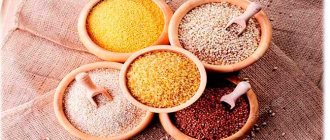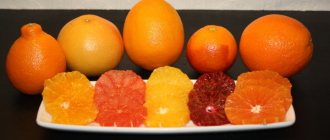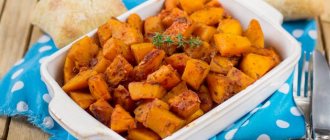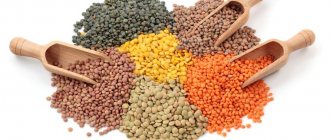The glycemic index (GI) of a product is determined by the rate at which it breaks down to form glucose in the body. Low GI foods break down more slowly. They gradually release glucose as they contain complex carbohydrates. The GI indicator is used by nutritionists to develop a proper nutrition system. It is based on replacing simple “fast” carbohydrates with “slow” ones and using low-calorie foods. This type of nutrition helps maintain a feeling of fullness for a longer period of time, while the body receives fewer calories than it expends, as a result the person loses weight. The concept of GI is closely related to the concept of insulin index (II).
What is the insulin product index
The insulin index is an indicator of how quickly and in what volume the body produces insulin when consuming a particular product. Insulin production is called the insulin response or wave.
The carbohydrate processing process is carried out as follows:
- carbohydrates contained in food are absorbed by the intestines;
- then they break down into saccharides, after which they enter the blood, increasing sugar levels;
- sugar is absorbed by insulin produced by the pancreas;
- insulin transports sugar into organ tissue cells;
- saccharides entering tissue cells are converted into energy;
- excess saccharides are deposited in the liver as glycogens;
- carbohydrate reserves are depleted, and insulin begins to absorb glycogens;
- When all glycogen is used up, the body signals the need to replenish reserves with a feeling of hunger.
If there are a large number of fat cells, the process of insulin transferring saccharides to the organs becomes more difficult. As a result, sugar is retained in the blood, which can lead to diabetes.
Calculation methods
The AI value of products is calculated through testing. First, the experimental subjects eat a certain product, and then every 15 minutes for 2 hours their blood is taken for analysis. By comparing insulin and glucose values in different blood samples, the product's AI is established.
The first insulin index table was created at the University of Sydney. It included 38 basic food products. The indicator initially taken as a guideline was the one recorded after eating a piece of white bread containing 240 kilocalories. In the following years, AI was installed in many other products. Now, if you wish, you can find and download a table with the desired product or, for example, with a complete list of researched positions, arranged alphabetically.
As the results showed, the insulinemic and glycemic index values for vegetables and fruits are the same. Oranges, bananas, berries, and cereals showed average results. Chocolate, caramel, boiled potatoes, legumes have a high insulin index. The AI score of yogurt (115) was higher than that of white rice (75). The index of meat and fish varies depending on the type and type of heat treatment.
High score products
Below is a list of products with particularly high AI. Some of them are clearly unhealthy and it is advisable to abandon them. But there are also products on the list that must be included in the diet. They cannot be excluded, but their indicators must be taken into account when creating a menu.
| Products | Insulin index |
| Caramel candies | 160 |
| Chocolate bar with condensed milk and nuts | 122 |
| Boiled potatoes | 121 |
| Stewed beans, beans | 120 |
| Store-bought yogurt | 115 |
| Dates | 110 |
| Dark beer | 108 |
| White bread | 100 |
| Natural yogurt, kefir and other fermented milk products | 98 |
| Black bread | 96 |
| Wheat flour cookies | 92 |
| Milk, regardless of fat content | 90 |
| Ice cream from the store | 89 |
| French cracker | 87 |
| Cupcakes, fresh grapes, cake, brownies from the store | 82 |
| Bananas | 81 |
| White rice | 79 |
| Donuts with jam filling, French fries | 74 |
| Brown rice | 62 |
| Chips | 61 |
| Oranges | 60 |
| Apples, fish | 59 |
| Whole grain bread | 56 |
Low score products
Low insulin response foods are ideal for dieters. It can be introduced into the diet menu with less caution. Below is a table with some products that have low AI.
| Products | Insulin index |
| Popcorn | 54 |
| Beef, regardless of cooking method | 51 |
| Lactose dissolved in water | 50 |
| Muesli with dried fruits | 46 |
| Cottage cheese, cheese - regardless of fat content | 45 |
| Fresh oatmeal, cooked TSP pasta | 40 |
| Boiled chicken eggs | 31 |
| Raw green lentils and pearl barley, grapefruit, dark chocolate, fresh cherries | 22 |
| Raw peanuts and soybeans, fresh apricots | 20 |
| Cabbage, garlic, bell peppers, broccoli, eggplant, herbs, mushrooms, onions, tomatoes - all fresh | 10 |
| Seeds | 8 |
Principle of using indicators
If a person is insulin dependent (hypoglycemic syndrome is present), then these indicators will help individually calculate the dosage for insulin injections. For other people, this data allows them to avoid insulin spikes, which lead to an exacerbation of hunger, as well as blocking the production of lipase, which is necessary for the natural process of burning subcutaneous fat.
Diet with AI in mind
Thanks to research related to the processes of insulin formation in the body, it has become possible to develop the most effective, safe diets for health. Nutritionists, based on AI data, have derived several important rules that should be taken into account by everyone who adheres to a healthy diet:
- the feeling of hunger increases when snacking on dairy and fermented milk products;
- you cannot combine foods with a large gap in AI indicators (for example, boiled potatoes should not be washed down with yogurt, and it is better not to drink beer with fatty foods);
- foods that have a high glycemic and insulin index should be consumed as rarely as possible;
- fruits with high and low index should be alternated;
- in the first half of the day it is better to eat food with a high AI, and in the evening you should eat mainly vegetables, fish, and other foods with low levels of both indices.
Marathon runners and sprinters
Fast carbohydrates
are absorbed not just well, but almost instantly, causing a sharp rise in blood sugar. And, as soon as the energy is used, the sugar level drops sharply, causing an attack of hunger and a desire to throw another portion of fuel into the firebox. True, it is much easier for an economical body to use only fast carbohydrates for energy, so all other sources - for example, fats - go into reserves on the sides. Of course, a person could eat only refined sugar, which contains nothing but fast carbohydrates, if the pancreas did not suffer. She is forced to produce a huge amount of insulin in a short time, and then freeze until the next portion of fast carbohydrates. When working in this mode, its cells quickly wear out, stop working and can even degenerate into cancer. In addition, the production of the good mood hormone - serotonin - depends on fluctuations in blood sugar levels. True, the mood will worsen again as soon as the digestion of fast carbohydrates comes to an end.
What is the glycemic index of foods
The glycemic index measures the level of glucose that occurs in the body when a food is consumed. This indicator may differ from the insulin response value. The thing is that insulin not only regulates sugar levels, but also participates in the process of amino acid synthesis. Therefore, it increases with the consumption of any food. Glucose increases only when food high in sugar enters the body.
The GI of food depends on several factors:
- type of carbohydrates contained;
- heat treatment option;
- percentage of fat, protein and fiber content;
- storage conditions.
Calculation methods
To calculate the GI of a product, a study is conducted with the participation of several volunteers. They drink 50 grams of glucose powder, after which their blood is taken every 15 minutes for a sugar test for 2 or 3 hours. The data is recorded, and after complete recovery, the experiment is repeated, but instead of glucose, the subject consumes a certain product. A serving of the product is calculated so that it includes 50 grams of carbohydrates.
Calculating GI is needed not only to determine product indicators. Blood sugar testing should be done for diabetics and people at risk of developing diabetes. Today it is possible to determine the glycemic profile at home using a glucometer. Such tests are especially necessary during pregnancy and prediabetic conditions.
Glycemic index of foods
Table of foods with a high glycemic index:
| Products | Glycemic index |
| Beer | 110 |
| Hamburger, dates | 103 |
| Fried croutons, rutabaga, bagels, starch, glucose, white bread | 100 |
| Potato casserole, baked or fried potatoes, parsnips, bun | 95 |
| White rice, canned apricots, peaches, pies, rice noodles, honey, hot dog | 90 |
| Corn flakes, boiled or stewed carrots, rice milk pudding, popcorn, celery root | 85 |
| Mashed potatoes, crackers, caramel, muesli with raisins, lollipop, donut, condensed milk | 80 |
| Watermelon, pumpkin, lasagna, unsweetened waffles, French baguette, zucchini caviar, milk rice porridge | 75 |
| Millet, pearl barley, semolina, milk chocolate, sweet gas. water, brown and white sugar, Mars bars, croissant, chips, couscous, halva, MSP pasta, cheesecakes, jam, packaged juice | 70 |
Table of foods with medium and low glycemic index:
| Products | Glycemic index |
| Wheat flour | 69 |
| Instant oatmeal, pineapple | 66 |
| Orange juice, stewed or boiled beets, jam, black yeast bread, jacket potatoes, muesli with sugar, sweet potatoes, canned vegetables, fruits, whole grain and rye bread, marshmallows, pasta with cheese, fruit wafers, marshmallows | 65 |
| Pancakes, dumplings, black tea with sugar, coffee, dumplings, long grain rice, cocoa, sour cream, melon, oatmeal, mayonnaise, ice cream, lasagna, pizza, pancakes, bananas | 60 |
| Processed cheese, shortbread, feta, margarine, mustard, sushi, grape juice, spaghetti, ketchup, canned corn | 55 |
| Egg, omelet, yolk, natural coffee without sugar, fish cutlets, fried beef liver, pork schnitzel, sweet yogurt, brown rice, cutlets, orange, mango, kiwi, sugar-free pineapple, apple and cranberry juice, persimmon | 50 |
| Dry champagne, wines | 44 |
| Crab sticks, eggplant caviar, dried apricots, beef, carrot juice, prunes, fresh orange, TSP pasta, basmati rice, buckwheat, grapefruit juice, coconut, canned green peas, whole grain bread | 40 |
| Boiled sausage, fructose ice cream, sesame seeds, soy sauce, plum, 0% natural yogurt, quince, apples, vermicelli, chickpeas, Chinese noodles, fresh green peas, wild rice | 35 |
| Tomato juice, peach, nectarine, sugar-free compote, pomegranate, beans | 34 |
| Chicken, tangerine, milk, blueberries, lingonberries, pear, tomato, beets, green beans, lentils, soy milk, green bananas, passion fruit, dark chocolate, blueberries, sugar-free jam, low-fat cottage cheese, pear, garlic, grapefruit, apricot | 30 |
| Yellow crushed peas, soy flour, pumpkin seeds, strawberries, raspberries, full-fat kefir, gooseberries, strawberries, red currants, cherries | 25 |
| Seaweed, soy yogurt, artichoke, lemon, eggplant | 20 |
| Olives, olives, kefir, pickled cucumbers, black currants, bran, soybeans, peanuts, spinach, leeks, tofu cheese, mushrooms, onions, zucchini, asparagus, chili peppers, ginger, cashews, broccoli , celery, almonds, Brussels sprouts, cauliflower and white cabbage, hazelnuts | 15 |
| Green pepper, avocado | 10 |
| Sunflower seeds, lettuce | 9 |
| Hard cheese, oregano, vanillin, shrimp, parsley, dill | 5 |
People engaged in heavy physical labor, as well as professional athletes, consume more foods with a high GI. Otherwise, they will not be able to replenish energy costs. For healthy people with normal weight and low energy expenditure in daily life, it is recommended to alternate foods, giving preference to foods with medium and low GI values.
For those who are overweight and want to get rid of it, as well as for people with a sedentary lifestyle, products with a GI lower than 49 are recommended. These same products should become the basis in the diet of a person suffering from metabolic disorders or diabetes.
Menu taking into account GI
When compiling a diet taking into account the GI of foods, various factors that influence this indicator are taken into account.
For example:
- An unripe banana has a GI of 40, and during ripening the figure reaches 65 units.
- The performance of apples also increases during the ripening process, but the intensity of the process is lower than that of a banana.
- Rye flour, coarse flour, whole grain bread contain fewer starch particles, and this leads to an increase in the glycemic index.
- When heated and refrigerated food is reheated, the glycemic index decreases.
- Starch tends to gelatinize when heated. For example, it is found in carrots, which in their usual raw form have a GI value of 20. But if you put it in a sandwich and heat it up, the value rises to 50. Therefore, many fast food dishes, which consist of an unbalanced set of components and are heated before serving, help increase glucose levels.
- Spaghetti and noodles, if prepared by extrusion (pressing), have a GI of 40. Similar products prepared in the classical way, even from TSP flour, have a GI of 70.
- Poultry fillet (breast) has a practically zero GI index.
The benefits of corn
Boiled corn
You should know about the beneficial properties of maize. The richest set of microelements is presented in the form of minerals, vitamins B, C, PP, phosphorus, potassium, fluorine, molybdenum, copper, iodine, etc. High calorie content has a positive effect on strengthening the general condition of the body. The product promotes bone growth and formation in weakened children.
Due to its high fiber content, dietary fiber perfectly cleanses the digestive tract, while strengthening the immune system. The content of beneficial enzymes normalizes the functioning of the stomach. In folk medicine, decoctions of stigmas are successfully used for inflammation of the bladder and kidneys. Eating corn helps cleanse blood vessels of bad cholesterol. Selenium present in the body slows down the aging process.
Expert opinion
According to colleagues who focus on AI and GI indicators, the first step to losing weight should be adjusting your diet. With a properly balanced diet, a person consumes more foods with low indexes. Healthy foods that contain a lot of carbohydrates and sugar should be consumed in the morning. During the day, it is advisable to eat dishes with medium and low AI/GI indicators. For evening snacks and dinner, products with minimal indexes are selected. By adhering to a well-designed “nutrition map”, a person gets rid of excess weight easily and quickly, without experiencing discomfort and without harming his health.










